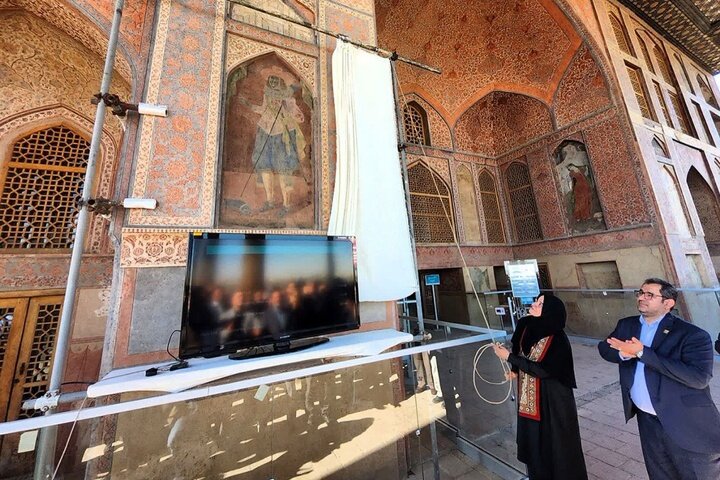Anthony Shirley's portrait restored and unveiled at Ali Qapu Palace

TEHRAN - A historic wall painting depicting the English diplomat Sir Anthony Shirley (1565–1635) has been restored and returned to its original location at the centuries-old Ali Qapu Palace in Isfahan.
The unveiling ceremony was held in conjunction with the opening of a tourism, handicrafts, and hospitality exhibition in the ancient city.
The event, attended by Maryam Jalali-Dehkordi, the deputy minister for handicrafts, Amir Karamzadeh, the director-general of cultural heritage, tourism, and handicrafts in Isfahan province, and prominent cultural heritage experts, celebrated the completion of a three-year restoration project.
Karamzadeh highlighted the restoration journey of the Ali Qapu Palace frescoes, which began in the 1960s when damaged sections of wall paintings were removed for preservation. In 2021, a comprehensive plan to restore and reintegrate these artworks, including stabilizing pigments and repairing damages, was initiated.
The restoration culminated in the reinstatement of the wall painting featuring Sir Anthony Shirley, a 16th-century English diplomat and military officer who played a significant role in fostering ties between England and Persia.
Shirley traveled to Persia in 1598, where he was warmly received by Shah Abbas the Great, the fifth Safavid monarch. Shirley’s mission sought to promote trade and alliances against the Ottoman Empire.
According to sources, the Shah honored him with the title of Mirza and granted privileges to Christian merchants, solidifying a key chapter in early Anglo-Persian relations.
As mentioned by The Guardian, in the Shah's palace of Ali Qapu, the wall paintings in his reception rooms illustrate a significant chapter in the history of globalization. In one room, there is a small painting of a woman with a child, clearly a copy of an Italian image of the Virgin; on the opposite wall, there is a Chinese painting. These pictures indicate Iran's capacity to absorb influences and demonstrate a cosmopolitan sophistication. Iran had become the crux of a new and rapidly growing world economy as links were forged trading china, textiles, and ideas across Asia and Europe. Abbas took into his service the English brothers Robert and Anthony Sherley as part of his attempts to build alliances with Europe against their common enemy, the Ottomans. He played European rivals off against each other to secure his interests, allying himself with the English East India Company to expel the Portuguese from the island of Hormuz in the Persian Gulf.
Located at the heart of Isfahan, Ali Qapu Palace, which is renowned for its intricate Safavid-era architecture and artwork, is part of UNESCO-listed Naqsh-e Jahan Square.
A city of historical significance
The ancient city of Isfahan, situated at the crossroads of Iran’s north-south and east-west trade routes, reached its zenith between the 9th and 18th centuries. During the Safavid era, it became Iran’s capital under Shah Abbas the Great. Renowned for its Persian-Islamic architecture, the city is home to historical landmarks such as Naqsh-e Jahan Square, a UNESCO World Heritage site.
Moreover, the ancient city was once a crossroads of international trade and diplomacy in Iran and now it is one of Iran’s top tourist destinations for good reasons. It is filled with many architectural wonders, such as unmatched Islamic buildings, bazaars, museums, Persian gardens, and tree-lined boulevards. It’s a city for walking, getting lost in its mazing bazaars, dozing in beautiful gardens, and meeting people.
The Persian proverb “Isfahan nesf-e-jahan ast” (Isfahan is half the world) reflects the city’s cultural and historical prominence.
AM
